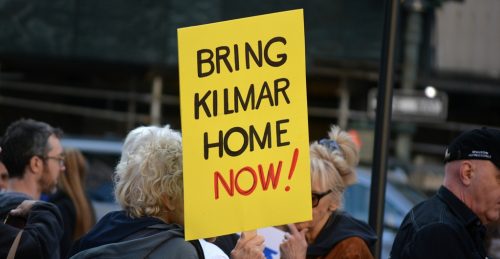Barely three weeks after the Fourth Circuit ruled that President Trump’s travel ban “drips with religious intolerance, animus, and discrimination” and thus violated the First Amendment by discriminating against Muslims, the Ninth Circuit ruled that the travel ban also violated the Immigration and Nationality Act (INA).
In upholding a Hawaii federal district court decision that blocked the travel ban nationwide, the Ninth Circuit Court of Appeals found that Trump violated the INA because he didn’t follow the law’s requirement to provide a sufficient rationale to block the entry of “more than 180 million” people. The Court also found that the travel ban violates the INA’s prohibition on national origin discrimination in the issuance of immigrant visas.
Taken together, the two decisions emphasize that the president’s authority over immigration is limited by both the Constitution and Congress. As the Ninth Circuit wrote, “immigration, even for the President, is not a one-person show.”
The Ninth Circuit’s decision comes after it heard arguments in an appeal of federal Judge Derrick Watson’s March order preventing the Trump administration from implementing the travel ban and blocking all nationals of six predominantly Muslim countries from entering the United States. A second judge in Maryland also blocked the order. That decision was appealed to the Fourth Circuit, which last month ruled that the travel ban was essentially the same “Muslim Ban” which President Trump had argued for on the campaign trail.
The Trump administration has appealed that other decision to the Supreme Court and asked the Court to issue an emergency stay. Undercutting their claim to urgency, earlier today the government asked the Court for an extra week to respond to the Ninth Circuit.
Trump has previously rooted his legal authority for the travel ban in a law which allows the president to “suspend the entry of… any class of [noncitizens]” if he “finds” that their entry “would be detrimental to the interests of the United States.” Invoking this authority, the second Executive Order claimed that the travel ban was necessary because each of the six countries was either “a state sponsor of terrorism, significantly compromised by terrorist organizations, or contains active conflict zones.”
The Ninth Circuit rejected this rationale entirely, finding that it improperly focused on the countries, and not the people included in the ban. “The Order makes no finding that nationality alone renders entry of this broad class of individuals a heightened security risk.” The court also found that the executive order failed to make any findings that nationals from the designated countries are tied to terrorist organizations or contribute to active conflicts. Most importantly, the order did not provide any link between an individual’s nationality and their likelihood to commit terrorist acts.
The Ninth Circuit then also held that the travel ban violates the INA’s anti-discrimination provision, which provides that “no person shall… be discriminated against in the issuance of an immigrant visa because of the person’s… nationality.” While groups such as the American Immigration Council have brought this claim in lawsuits against the travel ban, the Ninth Circuit’s decision is the first to find that the nondiscrimination provision provides an independent reason that the travel ban is unlawful.
Now that both the Ninth and Fourth Circuits have ruled against the travel ban, the Trump administration’s only hope is for the Supreme Court to overturn both courts. Monday’s decision makes this more difficult for the government. By ruling against the travel ban without invoking the Constitution, the Ninth Circuit has given the Supreme Court a roadmap to strike down the travel ban without diving into the thorny question of whether or not the travel ban is a “Muslim Ban.”
On Monday, challengers to the travel ban filed briefs asking the Supreme Court to leave both injunctions in place. Now, the Supreme Court has roughly two weeks to act before it recesses for the summer; if it fails to act before then, the Court would have to wait until it returns in October to take the case.
Photo by Hernán Piñera
 The American Immigration Council is a non-profit, non-partisan organization.
The American Immigration Council is a non-profit, non-partisan organization. 


